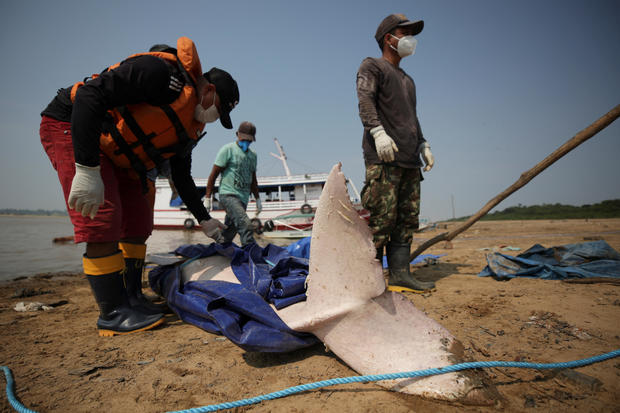When dolphins began washing up dead by the dozens on Lake Tefe in Brazil's Amazonas state, hydrologist Ayan Fleischmann was sent to find out why.
What he and his colleagues discovered was startling: a brutal drought and extreme heat wave that began in September 2023 had transformed the lake into a steaming cauldron. The lake's waters reached 41 degrees Celsius, or 105.8 degrees Fahrenheit — hotter than most spa baths.
Their findings, published Thursday in the journal Science, spotlight the impacts of planetary warming on tropical regions and aquatic ecosystems, and come as the United Nations' COP30 climate talks kick off in Brazil.
"You couldn't put your finger in the water," lead author Fleischmann, of western Brazil's Mamiraua Institute for Sustainable Development, told AFP.
He recalled the "psychological impact" of seeing the carcasses of Amazon River dolphins and tucuxis, another freshwater dolphin species.
 Researchers from the Mamiraua Institute for Sustainable Development recover a dead dolphin from Tefe lake, which flows into the Solimoes River, affected by high temperatures and drought, in Tefe, Amazonas state, Brazil, October 3, 2023.
BRUNO KELLY / REUTERS
Researchers from the Mamiraua Institute for Sustainable Development recover a dead dolphin from Tefe lake, which flows into the Solimoes River, affected by high temperatures and drought, in Tefe, Amazonas state, Brazil, October 3, 2023.
BRUNO KELLY / REUTERS
It's an "overlooked problem," he said, adding that tropical lakes, essential for the food security and livelihoods of local communities, have been far less studied than those in Europe and North America, and were assumed to be relatively stable.
While this study focused on 2023, another record-breaking drought happened in the Amazon a year later. Such events are becoming more frequent, severe, and longer-lasting as a result of human-caused climate change.
In all, the team visited 10 central Amazonian lakes, finding that five experienced exceptionally high daytime water temperatures exceeding 37 degrees Celsius, far higher than the 29-30 degrees Celsius considered normal.
The most extreme reading came from Lake Tefe, which saw its surface area shrink by about 75%.
According to the Consumer Product Safety Commission, a hot tub is typically set between 100 and 102 degrees Fahrenheit, or just under 40 degrees Celsius.
Officials from the World Wildlife Fund Brazil said 153 dolphins were found dead the week of Sept. 23, 2023, including 130 pink dolphins and 23 tucuxi dolphins. Both are listed as endangered on the IUCN Red List and the latter of which are considered "the guardians of rivers and a symbol of good luck," according to RiverDolphins.org.
"The climate emergency is here"
What made it even more remarkable, said Fleischmann, was that the same temperature was found not just at the surface but throughout the two-meter-deep water column.
Using computer modeling, the team identified four key drivers: strong solar heating, shallow waters, low wind speeds, and high turbidity — a measure of water haziness.
These factors reinforce one another. Shallowness increases turbidity, which traps more heat, while low wind carries less heat away, leaving the water more exposed to clear skies and intense sunlight.
Another stressor for aquatic life was the large swing between highs and lows, with the peak of 41C in Tefe followed by a nighttime low of 27C.
 A dead dolphin is seen at Tefe lake, which flows into the Solimoes river, that has been affected by the high temperatures and drought in Tefe, Amazonas state, Brazil, October 1, 2023.
BRUNO KELLY / REUTERS
A dead dolphin is seen at Tefe lake, which flows into the Solimoes river, that has been affected by the high temperatures and drought in Tefe, Amazonas state, Brazil, October 1, 2023.
BRUNO KELLY / REUTERS
Though much of the national and global attention focused on the more than 200 dead dolphins recorded in under two months, they represented only the tip of a wider socio-ecological crisis, with fish also dying in droves.
There was even a phytoplankton bloom that turned the lake red as the algae came under stress -- the subject of another forthcoming paper Fleischmann co-authored.
To understand longer-term trends, the researchers combed back through NASA satellite data beginning in 1990, finding that Amazonian lakes have been warming at roughly 0.6C per decade, higher than the global average.
"The climate emergency is here, there is no doubt about it," said Fleischmann.
He added he would be attending the COP30 summit to advocate for long-term monitoring of the Amazon's lakes and for greater inclusion of local populations -- including Indigenous peoples, non-Indigenous riverine dwellers, and Afro-descendant communities -- in developing solutions.
Research published in the journal Hydrological Processes found that droughts "have significant implications for river water temperature extremes" as radiation during these periods is more intense while water levels are lower and river velocities slow.
"Rising river water temperatures can have significant and often detrimental implications for aquatic life, impacting both individual species and entire ecosystems," study co-author and University of Birmingham professor David Hannah said. "Drought conditions often coincide with high atmospheric temperatures and such trends will become more intense and frequent with climate change."
How Earth can avoid a climate collapse
NASA scientist explains how Earth can avoid a climate collapse
(05:12)


















































